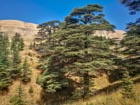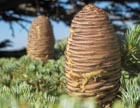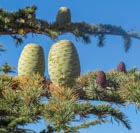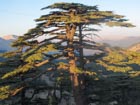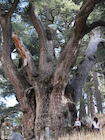Conservation Status

Cedrus libani
A. Rich. 1823
Common names
Lebanese cedar, cedar of Lebanon, レバノンシ-ダ- [Japanese].
Taxonomic notes
The Mediterranean cedars are all extremely similar in appearance and some authors have chosen to treat them all as infraspecific taxa of Cedrus libani. Nonetheless, molecular analyses have found consistent differences between the species of Cedrus. One analysis found C. atlantica sister to a clade of C. libani and C. brevifolia, with an estimated divergence between the eastern and western Mediterranean taxa at about 23 million years ago, and a divergence between C. libani and C. brevifolia about 5.3 to 10.5 million years ago (Qiao et al. 2007). Another study, using a new set of nuclear microsatellite markers, identified Lebanese C. libani as more similar to C. brevifolia than to Turkish C. libani (Karam et al. 2019), a result that argues for classifying C. brevifolia as a variety or subspecies of C. libani.
Syn: C. libanotica Link; C. libanitica (Trew) Pilger; C. libanensis Juss. ex Mirb.; C. cedrus Huth.; C. patula K.Koch (Vidakovic 1991).
A subspecies, C. libani subsp. stenocoma (Schwarz) Davis, found in SW Anatolia, is said to differ from the typical C. libani in having a pyramidal or columnar habit (Vidakovic 1991). Farjon (2010), however, regards this as merely an ecotype; he notes that it often occurs in pure stands or with Abies cilicica and thus assumes a columnar or pyramidal growth in response to competition for light.
Description
Trees to 40 tall and 250 cm dbh, with a single massive columnar trunk, or often forked low on the bole; rown first conical, later spreading horizontally. Bark cracking and becoming scaly with age, developing longitudinal fissures, blackish brown. Primary branches massive, often erect, later spreading horizontally; second-order branches usually spreading in horizontal planes. Twigs bear a long, slender leading shoot; otherwise short, firm, pale brown turning gray, shallowly grooved, at first with dark brown pubescence; short shoots thick, scaly, of variable length with age (0.5 to 4 cm). Vegetative buds ovoid, not or slightly resinous; bud scales broadly ovate, free at tips, pale brown with dark apex, deciduous. Leaves on long shoots spirally arranged, radially spreading, more crowded at base of the shoot; leaves in short shoots densely crowded, 20-35, most numerous on older short shoots, spreading radially, 20-25 × 1-1.5 mm, narrowly linear, straight or curved, quadrangular, acute or acuminate, with at least a few stomata on all surfaces; light to dark green, sometimes glaucous. Pollen cones terminal on short shoots, erect, subtended by leaves, numerous, 4-5 cm long, cylindrical, curved when ripe, pale green ripening to pale brown. Seed cones terminal on short shoots, erect, sessile, becoming woody in 2nd year, ovoid to cylindrical, with obtuse to depressed apex, (5-)8-12 × 3-6 cm, light green ripening to gray-brown; cone rachis persistent, narrowly conical. Seed scales broad rectangular flabellate, thin, coriaceous, 3-3.5 × 3.5-4 cm (wider than long); glabrous with orange-brown pubescent at base. Seeds 10-14 × 4-6 mm, brown, with a cuneate wing seed wings 20-30 mm long (Farjon 2010). See García Esteban et al. (2004) for a detailed characterization of the wood anatomy.
Flowers from June to September; cones ripen in fall of 2nd year and shed seed until spring. Appearance is extremely similar to C. atlantica; the primary difference is that the latter has smaller cones, with pollen cones to 4 cm long and seed cones to 8 cm long (Vidakovic 1991, Farjon 2010).
Distribution and Ecology
Native to Turkey, Syria and Lebanon, although planted in various locations around the Mediterranean since ancient times. In Turkey, occurs from the western Taurus Mountains, east to the province of Hayat; there are also two occurrences near the Black Sea; the area of occupancy is about 993 km2. In Syria, occurs at one location on the eastern side of Jabal an–Nusayriya, with an area of occupancy of only 1.5 km2. In Lebanon, occurs along the Mount Lebanon chain with an area of occupancy of 22 km2. Only some of the Taurus Mountains stands can be described as healthy, intact forest; through its remaining range, the forests are fragmented and degraded by factors of decline that include grazing, logging, urbanization, winter sports, and insect pests (Gardner 2015 and citations therein).
Cedars of the Mediterranean; C. brevifolia in yellow, and C. libani in orange. Distribution data from GBIF, 2021.02.17 and 2021.02.18.
C. libani occurs at elevations of (500-) 1,300-3,000 m, usually on N and W aspects on well-drained, mainly calcareous souls. Climate is cool with abundant winter snow at higher elevations and annual precipitation 1,000 to 1,500 mm. Typically in pure stands or with Abies cilicica, Juniperus excelsa, J. foetidissima, J. oxycedrus, Pinus nigra, P. brutia, and hardwood species such as Quercus cerris, Sorbus torminalis, and Prunus ursina. Forests typically transition to Pinus nigra, P. brutia dominance at lower elevations (Farjon 2010, Gardner 2015).
Hardy to Zone 7 (cold hardiness limit between -17.7°C and -12.2°C) (Bannister and Neuner 2001).
Dendrochronology has been used to assess the productivity loss associated with infestation by the cedar shoot moth Dichelia cedricola (Carus and Avci 2008).
Remarkable Specimens
Carder (1995) reported a tree 335 cm dbh on Mt. Lebanon in Lebanon; this may be the same tree shown in the photo at right. A tree in Villa Mirabello, Lombardia, Varese, VA, Italy has a 360 cm dbh and is 28 m tall (Alberi Monumentali d'Italia, a listing of big trees in Italy). A tree in Leaton Knolls, Shropshire, Great Britain is 113 cm dbh and 43 m tall (Mitchell et al. 1990).
The oldest known specimen, 619 years, is documented in a tree-ring chronology covering the period 1370-1988 (fully crossdated), collected W of Antalya, Turkey by Peter Kuniholm (doi.org/10.25921/zg3q-bx42). The 619-year lifespan was shown in two cores from one living tree. There is also a record of an exceptionally old cultivated tree: The Rectory garden at Childry, near Wantage, Oxfordshire, UK, has a tree grown from seed brought back from Lebanon by the Rev. Edward Pococke. Planted in 1658, the tree was still alive in 2002 when it was selected as one of the 50 Great British Trees (current status unknown). Monumental Trees (2013) notes that a tree close to the château in Rocamadour, France, is known to have been planted in 1685.
Ethnobotany
This may be the conifer with which humans have the longest recorded history. "Through five millenniums of recorded history, a parade of civilizations has praised the cedars of Lebanon — and then chopped them down. Lebanon has been deforested by Mesopotamians, Phoenicians and ancient Egyptians; by the Greek and Roman empires; by crusaders, colonizers and modern Middle East turmoil" (Barnard and Haner 2018). Farjon (2010) reports "About 4600 years ago King
Snefru of the Fourth Dynasty of ancient Egypt, who ordered the building of the pyramids of Dahsjur
and Meidum, used 40 shiploads of cedar timber for shipbuilding and for the heavy doors of the king's palace. It was undoubtedly used in similar ways before this earliest written record." The cedar is mentioned often in the Old Testament of the Bible. For example, the First Temple of Solomon was built of it (see 1 Kings 5:6). It also seems to have been the first species to receive any form of conservation protection: the Roman emperor Hadrian created an imperial forest by fencing off a Cedrus libani woodland and marking its perimeter with inscribed boundary stones, in order to conserve those woods (Bernabei et al. 2019).
Rania Masri (1995) provides this summary of the species historical importance:
The Cedar of Lebanon is cited numerous times in religion and mythology. In addition to its significant role in the Epic of Gilgamesh, the Cedar of Lebanon is regarded as a world tree in several mythological passages. One deeply mythological passage sees the imperial nation, the embodiment of history, under the figure of something like a world-tree [Ezekiel 31.1-18]. The cutting of the cedar is seen as the destruction of world-empires - really, as the end of history. Our understanding of ecology, the dependence of human history on maintenance of the natural environment, simply makes this primitive insight explicit.
Medicinally, the Cedar of Lebanon also made its mark. The pitch of the cedar was utilized for easing the pain of toothaches. The sawdust of the cedar puts snakes to flight, and thus makes sleeping under the shade of a cedar a relatively safe siesta. Furthermore, based upon historical analyses, it is believed that the cedar was used in the preservation of the corpses in Egypt.
... The Cedar of Lebanon aided society not only culturally but was the basis of numerous economies for ancient civilizations. The cedar had been used for the construction of temples, palaces, and boats. The export of cedar wood to Egypt was an important factor in the growth of Phoenician prosperity and provided capital to launch the more ambitious enterprises in international trading, navigation, and arts and crafts. The Phoenicians and the Egyptians were not alone in utilizing the cedar. The Assyrians, Nebuchdrezzar, the Romans, King David, King of Babylonia, Herod the Great, and the Turks in the Ottoman Empire all exploited the cedars. During the War of 1914-1918, most of the remaining stands were exploited and destroyed for railroad fuel. As a consequence, the extent of the cedars in Lebanon has dramatically declined.
The cedar's modern history can be dated from the 17th century, at which time it became a popular ornamental in the gardens of Europe; it has since grown to the status of one of the most popular ornamental conifers in temperate-zone gardens around the world.
The latest, and perhaps most severe human threat to the cedars is climate change, which "could wipe out most of the country’s remaining cedar forests by the end of the century" (Barnard and Haner 2018). There are a variety of factors at play here, familiar in climate change effects on forests around the world: increasing temperature, increasing aridity, increasing fire risk, and proliferation of pest insects are foremost among them. But the principal concern in Lebanon is that the trees have no place to go; they are already growing on the mountaintops. They cannot migrate upwards to more hospitable environments.
Observations
As noted above, the Taurus Mountains are said to have the best remaining wild stands of this species, but that is largely due to its occurrence in remote and inaccessible locations. Gardner (2015) notes that "there are extensive forests occurring from Boz Mountain (Acipayam) in the west and Ahir and Nur (Amanos) mountains in the east," but I have no more specific location information. Barnard and Haner (2018) note that significant extant stands include the Barouk Cedar Forest (part of the Shouf Biosphere Reserve, south of Beirut), and the Tannourine Cedars Forest Nature Reserve.
The Horsh Ehden nature preserve in Lebanon looks to be a very worthwhile place to visit and see this species; see Fareed (1999) for details.
The Cedars of Bsharre in Lebanon, now in a World Heritage Site, formerly included some remarkably large trees (Gardner 2015, citing a 1965 source).
The species is an extremely popular ornamental in Europe and North America, and is almost universal in arboreta and botanical gardens of the temperate zone.
Remarks
The epithet refers to Lebanon.
Citations
Barnard, Anne and Josh Haner. 2018.07.18. Climate change is killing the cedars of Lebanon. New York Times online, available https://www.nytimes.com/interactive/2018/07/18/climate/lebanon-climate-change-environment-cedars.html. Highly recommended; has some excellent drone videography of the cedar forests.
Bernabei, M., J. Bontadi, R. Rea, U. Büntgen, and W. Tegel. 2019. Dendrochronological evidence for long-distance timber trading in the Roman Empire. PLoS ONE 14(12):e0224077. https://doi.org/10.1371/journal.pone.0224077
Carus, S., and M. Avci. 2008. Growth loss of Lebanon cedar (Cedrus libani) stands as related to periodic outbreaks of the cedar shoot moth (Dichelia cedricola). Phytoparasitica 33:33–48.
Fareed Abou-Haidar. 1999.01.15. LebEnv #65: HIKING IN HORSH EHDEN PRESERVE. URL=http://almashriq.hiof.no/lebanon/300/360/363/363.7/fareed/lebenv65.html, accessed 2000.01.25.
Gardner, Martin F. 2015. Cedrus libani A. Rich. threatenedconifers.rbge.org.uk/taxa/details/cedrus-libani, accessed 2015.10.17.
Karam, Marie-Joe, Monique Aouad, Anne Roig, Audrey Bile, Magda Bou Dagher-Kharrat, Etienne K. Klein, Bruno Fady, and François Lefèvre. 2019. Characterizing the genetic diversity of Atlas cedar and phylogeny of Mediterranean Cedrus species with a new multiplex of 16 SSR markers. Tree Genetics & Genomes, https://doi.org/10.1007/s11295-019-1366-1.
Masri, Rania. 1995.11. The Cedars of Lebanon: Significance, Awareness and Management of the Cedrus libani in Lebanon. http://almashriq.hiof.no/lebanon/300/360/363/363.7/cedars2.html, accessed 2007.11.15.
Mitchell et al. 1990.
Monumental Trees. 2013. Lebanon cedar close to the château in Rocamadour. www.monumentaltrees.com/en/fra/lot/rocamadour/5524_chateau/, accessed 2013.02.16.
Qiao, C.-Y., J.-H. Ran, Y. Li, and X.-Q. Wang. 2007. Phylogeny and biogeography of Cedrus (Pinaceae) inferred from sequences of seven paternal chloroplast and maternal mitochondrial DNA regions. Annals of Botany 100:573–580.
Richard, A. 1823. Coniferae. P. 299 in J.B.G.M. Bory de Saint-Vincent et al., Dictionnaire classique d'histoire naturelle, Vol. 3. Available: Biodiversity Heritage Library, accessed 2012.11.25.
See also
The species account at Threatened Conifers of the World.
Elwes and Henry 1906-1913 at the Biodiversity Heritage Library. This series of volumes, privately printed, provides some of the most engaging descriptions of conifers ever published. Although they only treat species cultivated in the U.K. and Ireland, and the taxonomy is a bit dated, still these accounts are thorough, treating such topics as species description, range, varieties, exceptionally old or tall specimens, remarkable trees, and cultivation. Despite being over a century old, they are generally accurate, and are illustrated with some remarkable photographs and lithographs.
Hajar, L., François, L., Khater, C., Jomaa, I., Déqué, M., and Cheddadi, R. 2010. Cedrus libani (A. Rich) distribution in Lebanon: Past, present and future. Comptes Rendus Biologies 333(8):622-630.
